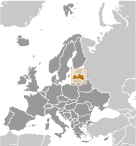
|
|
Advertisements:
GeographyLocation
Eastern Europe, bordering the Baltic Sea, between Estonia and Lithuania Geographic coordinates
57 00 N, 25 00 E
Map references
Europe
Area World Ranking: 124
Total 64,589 sq km
Land 62,249 sq km Water 2,340 sq km Area - comparative
Slightly larger than West Virginia Land boundaries
Total 1,382 km
Border countries Belarus 171 km, Estonia 343 km, Lithuania 576 km, Russia 292 km Coastline
498 km
Maritime claims
Territorial sea 12 nm
Exclusive economic zone 200 nm Continental shelf 200 m depth or to the depth of exploitation Climate
Maritime; wet, moderate winters Terrain
Low plain
Elevation extremes
Lowest point Baltic Sea 0 m
Highest point Gaizina Kalns 312 m Natural resources
Peat, limestone, dolomite, amber, hydropower, timber, arable land Land use
Arable land 28.19%
Permanent crops 0.45% Other 71.36% (2005) Irrigated land
8 sq km
Note Land in Latvia is often too wet and in need of drainage not irrigation; approximately 16,000 sq km or 85% of agricultural land has been improved by drainage (2003) Total renewable water resources
49.9 cu km (2005)
Freshwater withdrawal (domestic/industrial/agricultural)
Total 0.25 cu km/yr (55%/33%/12%)
Per capita 108 cu m/yr (2003) Natural hazards
NA
Environment - current issues
Latvia's environment has benefited from a shift to service industries after the country regained independence; the main environmental priorities are improvement of drinking water quality and sewage system, household, and hazardous waste management, as well as reduction of air pollution; in 2001, Latvia closed the EU accession negotiation chapter on environment committing to full enforcement of EU environmental directives by 2010 Environment - international agreements
Party to
Air Pollution, Air Pollution-Persistent Organic Pollutants, Biodiversity, Climate Change, Climate Change-Kyoto Protocol, Desertification, Endangered Species, Hazardous Wastes, Law of the Sea, Ozone Layer Protection, Ship Pollution, Wetlands Signed, but not ratified None of the selected agreements Geography - note
Most of the country is composed of fertile low-lying plains with some hills in the east
Comments
Add a new comment: |
Advertisement
Members area
Latvia (Riga):
 
GPS points from Latvia (Riga)
|
||||||||

 The name "Latvia" originates from the ancient Latgalians, one of four eastern Baltic tribes that formed the ethnic core of the Latvian people (ca. 8th-12th centuries A.D.). The region subsequently came under the control of Germans, Poles, Swedes, and finally, Russians. A Latvian republic emerged following World War I, but it was annexed by the USSR in 1940 - an action never recognized by the US and many other countries. Latvia reestablished its independence in 1991 following the breakup of the Soviet Union. Although the last Russian troops left in 1994, the status of the Russian minority (some 28% of the population) remains of concern to Moscow. Latvia joined both NATO and the EU in the spring of 2004.
The name "Latvia" originates from the ancient Latgalians, one of four eastern Baltic tribes that formed the ethnic core of the Latvian people (ca. 8th-12th centuries A.D.). The region subsequently came under the control of Germans, Poles, Swedes, and finally, Russians. A Latvian republic emerged following World War I, but it was annexed by the USSR in 1940 - an action never recognized by the US and many other countries. Latvia reestablished its independence in 1991 following the breakup of the Soviet Union. Although the last Russian troops left in 1994, the status of the Russian minority (some 28% of the population) remains of concern to Moscow. Latvia joined both NATO and the EU in the spring of 2004.